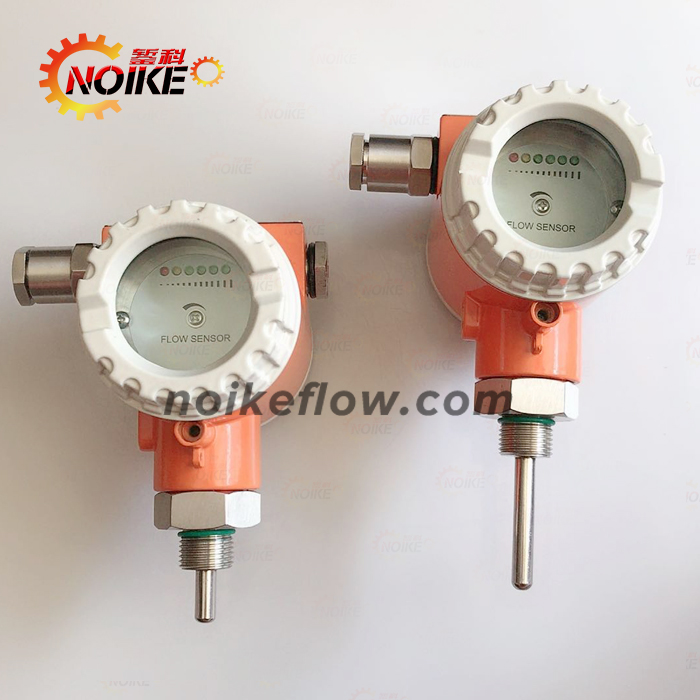Explosion-proof flow switch manual (explosion-proof grade)
Time: 2020-08-27 03:08:27 Click:0
The contents of the explosion-proof flow switch manual are roughly as follows, including the most common principles, application scenarios, and so on.
Introduction to the principle of explosion-proof flow switch (take electronic explosion-proof flow switch as an example):
The principle is mainly based on the thermal principle. The enclosed probe contains two resistors, one of which is heated as a detection resistor, and the other is not heated as a reference resistor. When the medium flows, the heat on the heating resistor is taken away, and the resistance value Is changed, the difference between the two resistances is used as the basis for judging the flow rate. The probe adopts anti-scaling coating, which can prevent the adhesion of scale, rust and other dirt in the pipeline, with stronger anti-fouling ability and more stable work.
No matter what principle the explosion-proof flow switch is, there will be a corresponding explosion-proof grade. According to the explosion-proof grade and classification, it can be used in hazardous situations requiring intrinsic safety or explosion-proof, and used to automatically protect equipment and piping systems from flow reduction or interruption. This is also the most important consideration when choosing an explosion-proof flow switch.
Explosion-proof flow switch manual (explosion-proof grade)
Appendix: IEC explosion-proof grade standard
IEC explosion-proof grade standard format: Ex(ia)ⅡC T4
An explosion is a matter that undergoes physical or chemical changes from one state to another state suddenly and releases huge amounts of energy. The energy released at a rapid speed will cause the surrounding objects to suffer violent impact and destruction.
Three conditions must be met for explosion:
1) Explosive substances: substances that can react with oxygen (air), including gases, liquids and solids. (Gas: hydrogen, acetylene, methane, etc.; liquid: alcohol, gasoline; solid: dust, fiber dust, etc.) 2) Oxygen: air. 3) Ignition source: including open flame, electrical spark, mechanical spark, static spark, high temperature, chemical reaction, light energy, etc.
Why explosion-proof
Explosive hazardous gas classification
According to the minimum spark energy that may detonate, the International Electrotechnical Commission (IEC) standards adopted by my country, Europe and most countries and regions in the world divide explosive gases into four hazard levels:
Explosion-proof level
Explosion-proof level (IIC includes IIB and IIA)
Ⅱ A Ethane, propane, styrene, xylene, benzene, carbon monoxide, acetone, acetic acid, ammonia, pyridine ethanol, butane, propylene, ethyl acetate, dioxyethane, vinyl chloride, chloroethanol, thiophene, cyclopentane Alkane, dimethylamine pentane, decane, ethyl cyclopentane, turpentine, naphtha, petroleum (including gasoline), fuel oil, pentanol tetrachloroethyl ether, trimethylamine
Ⅱ B Propyne, acrylonitrile, ammonia hydride, coke oven gas ethylene, ethylene oxide, methyl acrylate, furan dimethyl ether, acrolein, tetrahydrofuran, hydrogen sulfide, diethyl ether, dibutyl ether, tetrafluoroethylene, etc.
Ⅱ C Hydrogen, water gas acetylene
Maximum surface temperature grouping for class Ⅱ electrical equipment (T6 includes T5T4T3T2T1)
Maximum surface temperature of temperature group ℃
T1 450
T2 300
T3 200
T4 135
T5 100
T6 85
The national standard GB regulations on explosion-proof grade standards:
No. Explosion-proof type Code National standard GB Explosion-proof measures Applicable area
1 Flameproof type d GB3836.2 isolates the existing ignition source
2 Increased safety type e GB3836.3 Try to prevent ignition sources
3 Intrinsically safe type ia GB3836.4 limits the energy of the ignition source
Intrinsically safe ib GB3836.4 limits the energy of the ignition source
4 Positive pressure type p GB3836.5 Separate hazardous substances from ignition sources
5 Oil-filled type o GB3836.6 Hazardous substances are separated from ignition sources
6 Sand-filled q GB3836.7 Hazardous substances are separated from ignition sources
7 Non-sparking type n GB3836.8 Try to prevent ignition source
8 Encapsulated type m GB3836.9 Try to prevent ignition sources
9 Airtight h GB3836.10 Try to prevent ignition sources
Explosion-proof flow switch manual (explosion-proof grade)
Explosion-proof mark format description:
The explosion-dangerous medium in the factory or mining area is scientifically classified and classified according to its ignition energy, minimum ignition temperature, and the time period of the on-site explosive hazardous gas to determine the explosion-proof mark and explosion-proof form of the on-site explosion-proof equipment.
Explosion-proof mark format:
Ex(ia)ⅡC T4
Explosion-proof mark, explosion-proof grade, gas group, temperature group
Explosion-proof grade description:
ia level: Electrical equipment that cannot ignite explosive gas mixtures during normal operation, one failure and two failures.
During normal work, the safety factor is 2.0;
When a fault occurs, the safety factor is 1.5;
In the case of two failures, the safety factor is 1.0.
Note: Contacts with sparks must be equipped with flameproof enclosures, air-tight enclosures or double the safety factor.
ib level:
Electrical equipment that cannot ignite explosive gas mixtures during normal operation and a malfunction.
During normal operation, the safety factor is 2.0; for a fault, the safety factor is 1.5.
During normal operation, spark-proof contacts must be protected by flameproof enclosures or air-tight enclosures, and there are measures to self-display failures, and the safety factor is 1.0 for a failure.
In addition, the explosion-proof certification of the explosion-proof flow switch is also divided into domestic certification
National Quality Supervision and Inspection Center for Explosion-proof Electrical Products (CQST)
National Supervision and Inspection Station for Explosion Protection and Safety of Instruments (NEPSI)
China Petroleum and Chemical Industry Electrical Products Explosion-proof Quality Supervision and Inspection Center (PCEC)
And foreign certification
ATEX-European Commission quot;Equipment and Protection System for Potential Explosive Atmospheresquot; (94/9/EC) Directive (high effectiveness, internationally accepted)
CEE-International Electrical Equipment Approval Rules Committee
IEC--International Electrotechnical Commission
CENELEC--European Electrotechnical Standardization Organization
ISO--International Organization for Standardization
LLOYD#39;SREGISTER OF SHIPPING--Lloyd#39;s Register
BASEEFA--British Explosion-proof Electrical Equipment Inspection Agency
BSI--British Standards Institute
SFA--Special flammable atmosphere
F M--Factory Mutual Aid Research Society
U L--Underwriters Laboratory
NEC-National Electrical Code
LCIE-French Central Laboratory
DEMKO--Danish Electrotechnical Commission
DIN--German Standards Institute
BVS--German Mining Equipment Inspection Service
The main application areas of explosion-proof flow switches:
Petrochemical
Gas and liquid analyzer
Biomedical equipment
Atmosphere furnace
Gas Chromatograph
Vacuum system
Industrial fluid pipeline
As well as other dangerous working conditions, it can protect pumps, engines or other equipment from damage caused by low flow or cut-off. Pumps and other equipment can be operated in sequence, and auxiliary pumps and engines can be automatically started when the cooling system appears In the event of failure, the explosion-proof flow switch can immediately control and stop the work of cooling the engine.
You can refer to it according to the actual situation. If you encounter some incomprehensions or unclear working conditions, you can contact the staff of Chico to provide you with professional answers.

